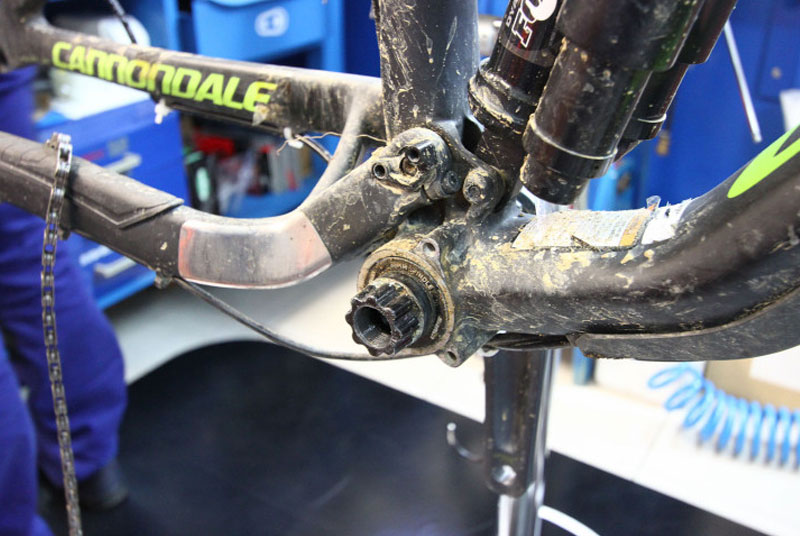How the Heck do you know When to Service your Bottom Bracket?
By Dave Batka – Founder of Wheels Manufacturing
“How do I know when it is time to maintain my bb?”
My usual response is “why does it matter? You aren’t going to work on it until it is busted anyway”. If you are one of those folks who actually wants your mechanical equipment running smoothly then keep reading. The rest of you can go back to riding your bike into the ground and when the BB seizes up, you can fix it at that time.
We pros had 2 quick tools to do BB work and the work was quick and easy. Sometimes you needed to replace some of the parts and sometimes the whole thing. I raced on this stuff in the 80’s and often it was the full deal replaced every year.
Along came a spider and behold the sealed BB was born. First models simply replaced the loose balls with sealed bearings but still square taper. Eventually our industry came up with fully enclosed units you just tossed in and they are/were basically non serviceable. They are still in use and come stock on many bicycles, especially lower end ones. These bottom bracket units can actually be pretty sturdy and can last for years or decades and the user pretty tosses in a new one when it seizes up in a rainstorm.
Fast forward to current bikes and a ton of different types of bottom brackets but they all share similar features of sealed bearings and cups to hold them in the frame. Most manufacturers aren’t putting serviceable units in the bikes when they leave the factory. Once you replace these low end units with a high quality Wheels Mfg Bottom Bracket, you can easily maintain them.
How often should I maintain my bottom bracket?
This is a tricky question but here’s the first basic questions I would ask to determine the answer.
- How often do you ride your bike (daily, weekly, seasonally)? Not just miles but number of days per year and frequency.
- How many miles do you ride monthly.
- Do you ride seasonally? Do you ride all summer and then store your bike for the winter? That sort of thing.
- What type of rides do you generally do on this bike? Road, gravel, singletrack?
- What general conditions to you ride in? Wet, dry, dusty, etc?
The two most important questions here are:
a) How many miles per month do you ride
b) What type of conditions do you ride in
b) What type of conditions do you ride in
Plenty of questions come from folks who tell me “My bottom bracket needs work every 3 months. Why?” And I find out they ride 1000 miles a month. Or I hear “I’ve only got 250 miles on this bottom bracket and it is done in” and they ride through creeks on every ride.
The two biggest wear factors are miles and contamination. In my experience contamination is the most important. Fill that thing up with water or dusty stuff every day and it isn’t going to last long. Ride a lot of miles and that will do it in as well.
In our lab at Wheels Mfg, I tested bottom brackets for mileage wear. Keep in mind we are in a lab without any environmental concerns like dust or moisture. Just miles. This is what our research found.
Average lifespan of a el cheapo OE bottom bracket. 500 miles
Average lifespan of a basic Abec-3 Wheels Mfg bottom bracket. 2000 miles
Average lifespan of a angular contact Wheels Mfg bottom bracket. 5000 miles.
Ceramic bearings lifespan varies greatly and is very dependent on conditions. I do not recommend Ceramic bearings be used day to day or for high mileage applications. If you own ceramics do plan on maintenance every 500 miles.
This was done in a lab, in perfect conditions. Next we started testing outside. We tested our bottom brackets on mountain bikes and road bikes, in wet climates and dry. What we found was again the basic bottom bracket on your bike from the factory isn’t going to last longer than 500 miles. Wheels Mfg brackets lasted substantially longer BUT the mileage varied greatly with climate and contamination.
I maintain my bottom brackets every 1000 miles on my own bikes. I ride mostly gravel and road and bone dry here in Colorado. Even though angular contact bearings last longer, they still need maintenance.
What if you ride 10,000 miles a year? You need to do a lot of maintenance.
What if you don’t ride but barely 1000 miles per year? You still need to plan on yearly maintenance.
More about all this in next week’s blog.
I’d love to hear from you with your comments at BPDtechguy@gmail.com

